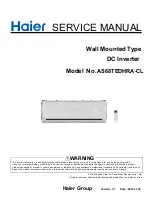
1-53
1
1
9-5. Caution for Ducting Work
•
This unit has high static pressure.
In case of small pressure resistance (for instance, a short duct), install an airflow control damper (field supply)
for adjusting airflow volume as airflow volume / airflow noise increases.
•
If the air conditioner is to be installed in a room such as an office or meeting room which needs a low sound
level, provide a supply and return sound absorption chamber with an acoustic liner.
•
Use a flexible canvas connection or vibration isolation hanger (field supply) to break transmission of
mechanical vibration of the unit.
Sound absorbing chamber
Sound absorbing chamber
Air filter (field supply)
Inspection
opening
Ceiling panel
Indoor unit
Thermal
insulation
Thermal
insulation
Air-discharge
Air intake
Canvas connection
Sound absorbing chamber
Airflow control damper
Fig. 1-16
•
Use incombustible duct materials.
•
Use thermal insulation to prevent duct condensation.
•
An air filter (field supply) must be installed at the air intake side.
If not installed, the heat exchanger will get dirty and the unit will reduce the quality.
•
Obtain and install an air filter (field supply) which can easily wash away the dust by lukewarm, soapy
water orsuck up with a vacuum cleaner.
•
Clean the air filter periodically to collect dust and other particles from the air.
•
Use duct static pressure within a range of specification value.
CAUTION
9-6. External Static Pressure Setting
Choose one of the methods (selection of “a”, “b”, “c” within the range of dotted line as shown in the flowchart below)
and make settings.
a. No setting changes:
When using as it is factory preset at shipment.
(If resetting after external static pressure setting once, it might be different from factory preset.)
b. Manual setting (on PCB):
This is static pressure setting excepting factory preset at shipment. Dip switch select method.
c. Manual setting (by timer remote controller):
Static pressure setting excepting factory preset at shipment.
Flow of External Static Pressure
NOTE
(1) Refer to Table 1-4, 1-5 and Fig. 1-18 for details on the relationship between the value of item code “5d” and the
external static pressure.
(2) When set in group control (connecting multiple indoor units with one timer remote controller), set each indoor
unit to item code “5d”.
When amending the setting after selecting [ b. Manual setting] (due to airflow path changes, etc.), it is
necessary to cancel [b. Manual setting] (switching OFF positions).
When [b. Manual setting] has not been cancelled, [c. Manual setting] will be activated if selected, but [b. Manual
setting] takes precedence when the power is switched back on after power outages, etc.
Make sure the external static pressure is in a range of specifications.
Then proceed the external static pressure setting.
Improper settings can cause noise, a shortage of airflow volume and water
leakage.
Refer to Fig. 1-18 for the external static pressure setting range.
Be sure to set the [External Static Pressure Setting] once again after amending
the airflow path for the duct or air outlet after setting the external static pressure.
Start of external static pressure setting
Setting of shipment : line 5
Is it designed
and installed at the setting line
at shipment on PQ line drawing?
See the section 9-6-4.
Operating by
timer remote
controller
Selection methods
of external static
pressure setting
No
No
Yes
Yes
a. No setting changes
b. Manual setting
(Setting on PCB)
Setting switches of TP6 or
TP3 or TP1
Refer to section "9-6-1. How to
set on PC Board".
c. Manual setting
Item code 5d : Setting 1, 3, 6
(*Note 1) (*Note 2)
Refer to section 9-6-2. or 9-6-3.
Completion of external static pressure setting
CAUTION
SM830252-01_欧州_Single_8・10HP_TD_SM.indb 53
16/10/14 13:57:21
AMP Air Conditioning
www.ampair.co.uk | [email protected]
















































